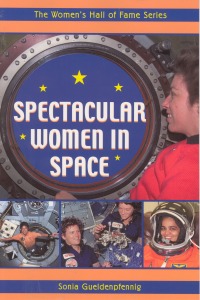| ________________
CM . . .
. Volume XI Number 14 . . . . March 18, 2005
excerpt:
The fifth book in Second Story Press's "Women's Hall of Fame Series," Spectacular Women in Space does indeed examine, through profiles of 10 extraordinary women, this powerful urge to explore the final frontier. All of the 10 chapters, none of which is more than a dozen pages, work together to give us an engaging portrait of the role women have played in space history. And yet, only seven of the 10 women Sonia Gueldenpfennig chose to write about ever actually got to space. In this way, the author acknowledges the tremendous debt owed by those who made it to those who never did. It's a good reminder for us all that for every woman who stands in the spotlight, there are dozens of others back in the shadows. One of those previously shadowy presences is Caroline Herschel, an eighteenth-century astronomer whose many accomplishments included the discovery of eight comets and three galaxies. Herschel's amazing story, which opens the book, reminds us of how bleak and limited most women's lives once were (considered unmarriageable because of the damage wrought by both smallpox and typhus, she was a virtual slave to her own mother until rescued by her remarkably forward-thinking brother William), and it provides some good context for the life histories that follow. If there had been no Caroline Herschel, Gueldenpfennig seems to be asking, would we ever have had Jerrie Cobb, the first woman to merit serious consideration as an astronaut candidate and a true pioneer for women in space? The holder of several world aviation records, Cobb was summoned to NASA in 1959 when an official had the bright idea of manning (pardon the pun) the weight-sensitive early spacecrafts with small, light women instead of big, bulky men. She was soon joined by a dozen other female pilots, and they nicknamed themselves the Mercury Thirteen (after the first group of male astronauts, the Mercury Seven). But the Mercury Thirteen were quickly caught up in a Catch-22 of surreal proportions when NASA declared that only jet test pilots would be allowed to become astronauts. Because women were not permitted to fly jets for the military, they were automatically excluded. Cobb never realized her dream of going to space, but she did pave the way for those who came after her. Gueldenpfennig includes here the story of the first woman in space, Valentina Tereshkova, even though her trip was little more than a publicity stunt (no other Russian women went to space for almost two decades). Also profiled are Sally Ride, the first American woman in space, and Roberta Bondar, Canada's first. Japan's first female astronaut, Chiaki Mukai, gets a chapter, as does the late Kalpana Chawla proof that Gueldenpfennig has tried to give her book some international scope (no easy feat, given that so few countries have active space programs). In each chapter, Gueldenpfennig often focuses more on how the women got to be astronauts than on what they did once they'd slipped the surly bonds of earth. This is an interesting approach that will especially appeal to young girls who are themselves dreaming of space and want some ideas on how to get started. Throughout, Gueldenpfennig's writing style is generally straightforward, though definitions of difficult terms are sometimes worked in a little clumsily. The book probably would have benefitted from a glossary and even an index. Occasionally, a few mistakes also creep in (the space shuttle Endeavour, named for James Cook's ship, should be spelled with a "u," and the Johnson Space Center picks up a rogue "t" at least once). And a personal pet peeve of mine is the common habit of calling women by their first names. This is meant to be a more intimate, accessible approach, but surely Canada's first female astronaut has earned the right to be called Bondar, or even Dr. Bondar, instead of the overly familiar Roberta! One final small quibble is with Gueldenpfennig's decision to end the book with the story of Nadezhda Kuzhelnaya. She's a cosmonaut who was passed over for missions several times including once in favour of the American "space tourist" Denis Tito and eventually quit the Russian space program without ever getting to blast off. When she demanded to know why she was never chosen, she was told it was because she was too small to fit the standard spacesuit properly. The parallels to Jerrie Cobb's experience are obvious and undeniable: more than 40 years later, the male officials who run the space agencies are still fabricating reasons for why women cannot participate. In fact, Gueldenpfennig uses Kuzhelnaya's story to make the point that all space programs are still, by and large, designed by men for men, and that we won't have more women in space until that reality changes. But given the great distances traveled, both literally and figuratively, since Caroline Herschel's day women have piloted shuttle missions, operated the Canadarm, lived on the International Space Station, and given their lives to further our knowledge of space it seems a shame to end what is otherwise quite an enjoyable book on such a negative note. Recommended. Janice Weaver is a Toronto-based writer and editor who likes to keep her feet planted firmly on the ground.
To comment
on this title or this review, send mail to cm@umanitoba.ca.
Copyright © the Manitoba Library Association. Reproduction for personal
use is permitted only if this copyright notice is maintained. Any
other reproduction is prohibited without permission.
NEXT REVIEW |TABLE OF CONTENTS FOR THIS ISSUE
- March 18, 2005.
AUTHORS
| TITLES | MEDIA REVIEWS
| PROFILES
| BACK ISSUES
| SEARCH | CMARCHIVE
| HOME |
